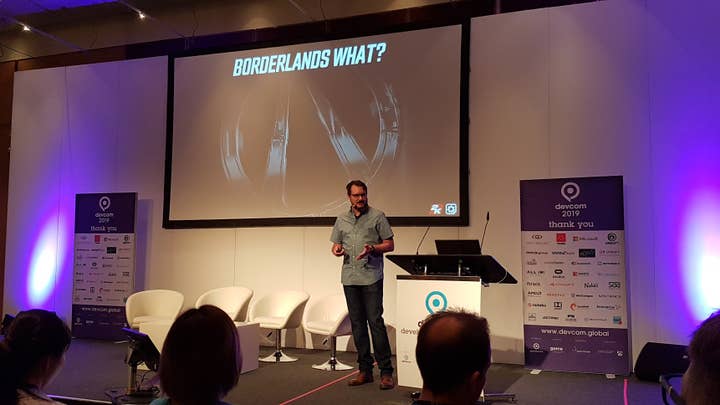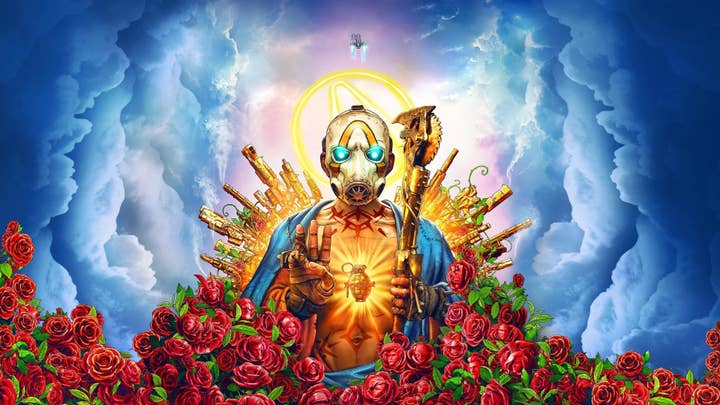Borderlands 3's secret weapon is in the writers' room
At Devcom, Gearbox Software's Randy Varnell detailed the creation of a "narrative department" to meet the challenge of Borderlands 3
Video game sequels tend to increase in scope and size. And for Borderlands 3, Gearbox Software has quadrupled its capacity in an unexpected area: writing.
Speaking at the Devcom conference this week, head of world development Randy Varnell said that Gearbox has generally created its games with a single dedicated writer on the team. For Borderlands it was Mikey Neumann, on Borderlands 2 it was Anthony Burch, for Battleborn it was Aaron Linde.
All of them are "tremendously good, talented writers," but the amount of resources Gearbox devoted to writing didn't necessarily scale up with the amount that actually needed to be done.
"If you've played any Borderlands, you know that the games are not small," Varnell said. "There is a lot of dialogue, there is a lot of story, there are a lot of lines said, and when we came to Borderlands 3, we knew we were gonna make the game even bigger than before."
"We knew we didn't want to kill off any more writers. We wanted a department to share the workload"
The ambition of Borderlands 3, which launches on September 13, would have been "really hard for one writer to take." Indeed, the scale of the task was such that Gearbox created an entire "narrative department" to meet it -- the first such unit to exist at Gearbox since it was founded 20 years ago.
The narrative department includes a resident voice-over artist, a pre-visualization team and, crucially, four dedicated writers. That unit worked with the creative leads from the other key areas of the production, and reported to the company's senior leadership.
"Before, it was just a lot for one writer to tackle," Varnell said. "At the end of a project, writing so many lines, and having to work so heavily on iteration, on polish, on working individually with mission designers and level designers, there just wasn't a lot of writer to go around.
"We knew we didn't want to kill off any more writers. We wanted a department to share the workload a little bit."
"We get told all the time that our jokes aren't funny. We get told all the time that our jokes are hysterical. We don't know which is true"
This has allowed the writers to work more closely with every single department, firmly grounding each aspect of Borderlands 3 in its narrative. It is also enough people for a "writers' room," which fostered a creative dynamic that didn't exist on the previous Borderlands games.
"Writers' rooms are really cool, y'all," Varnell said. "Humour is really, really hard to get right. We get told all the time that our jokes aren't funny. We get told all the time that our jokes are hysterical. We don't know which is true.
"When you have a writer's room, when you have a group of people practising your craft with you, people you can constantly bounce ideas off of... It really means that there's a greater chance that our jokes, that our humour, will be more appealing to a broader group of people.
"Half the time I can't even find my writers, because they've run off and gone to a room and they're punching up some particular mission or dialogue. They do a great job, and you're going to see that and feel that in Borderlands 3."

In the Q&A session after his talk, Varnell discussed why it has taken Gearbox 20 years to establish a narrative department, and have a group of people all contributing to the writing rather than just one or two. The main reason, he said, is scale; Gearbox was a "tiny studio" when it first started, just "five or six people working on ports."
"Borderlands was a team of only 60 or 70 people," he said. "It was not a huge team, and the game didn't have the scope or depth of story as the later games have. Our ambitions increased, the size of the games increased, and for a while we thought, hey, we can keep just one writer.
"Sometimes we're not quite as good as we think we are at really managing people well"
"Sometimes we're not quite as good as we think we are at really managing people well. There are a lot of reasons that people get burnt out from working, and we absolutely chewed up and spat out poor Aaron Linde. He's one of my best friends, but man, Battleborn was a rough project for him. He wrote his heart into that game. He wrote lots of dialogue for 30 different playable characters, as well as a full-on campaign narrative.
"It can take a couple of projects sometimes to really develop that perspective. But I think the biggest reason is that there was a time when we were a much smaller team, and the projects were much smaller."
Borderlands 3 is an order of magnitude greater again in many areas, but in writing most of all. Varnell was reluctant to discuss numbers and proportional increases, but he said there are between 30,000 and 40,000 lines of dialogue in the game -- by far the most of any entry in the series.
Borderlands was originally sold on the volume and variety of guns it was possible to find in its sprawling wasteland. The third game will be an acknowledgement that it has persisted and thrived not just because of carnage, but because of the characters that Gearbox has written into existence.
If there was any doubt about that, Varnell quickly eradicated it with a series of photos of the many fans who have tattoos of Claptrap and friends. People you have never met permanently etching things you conjoured out of your imagination onto their bodies is a strange feeling, he admitted. In fact, there is one person who already has a tattoo of the Borderland 3 box art.
"That's weird, and I love it. For those people's sake, I really hope the game is good."
Varnell added: "Don't worry. It is."
GamesIndustry.biz is a media partner of Devcom 2019. We attended the show with assistance from the organiser.

